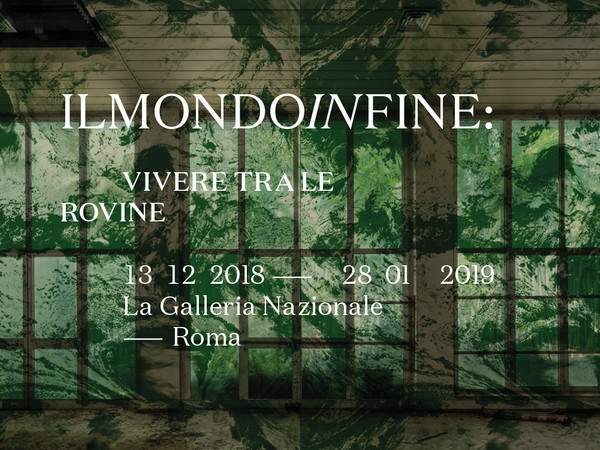From December 13, 2018 to January 29, 2019, the National Gallery of Modern and Contemporary Art in Rome is hosting the exhibition Ilmondoinfine. Living among the Ruins, a contemporary art group show that aims to answer a specific question: “can an exhibition help us reflect on environmental collapse, the depletion of resources, the crisis of Western forms of life and its institutions, and help to relocate our position as humans vis-à-vis the planet on which we live in an era that for some has become the geological era of the Anthropocene?” And more specifically, “can an exhibition help us think about a present and a future in which homo sapiens sapiens is called upon, in addition to accounting for the devastation of which he is the bearer, to relocate himself in relation to other living things?”
The exhibition, the presentation goes on to say, wants to see “in living among ruins a paradigm of the present condition to be reversed into an occasion. Because the ruins among which we live are, yes, those of industrial civilizations and plunder, of the predation of a capitalism that leaves rubble and waste in its wake, but also those among which the hybrid life of plants, animals and humans, stubbornly returns to proliferate pointing the way to other possible worlds. For life has always unfolded among the ruins of previous worlds, in an ongoing process in which what ends is also what begins. To grasp the ambivalence between a world in the end and a world at last is to learn to stand on the threshold of continuous transformation, in a becoming in which there will be no previous orders to restore, missing conditions to fill, temples to rebuild, and one will stop looking to the past as that wholeness which the present erodes and to the future as that which the present lacks. To question contemporary art and its ability to stand on this threshold, along with the presence of objects from worlds in the end, is to return to attributing to art, among all human techniques, the privileged ability to know how to make the world.”
These aspects will be explored with works by Emanuele Becheri, Chiara Bettazzi, Gigi Cifali, Felice Cimatti, Virginia Colwell, Rosetta S. Elkin, Christoph Keller, Fiamma Montezemolo, MP5, Pietro Ruffo, Gian Maria Tosatti, Massimiliano Turco, and Franco Zagari. The exhibition consists of an arrangement of works inserted in a signifying chain completed by curatorial work through objects of different status from contemporary art. The whole is aimed at interrogating the continuous creation and crisis of the capacity to make the world expressed as much by art as by the complex of human practices, whether technical, ritual, scientific, cultural or aesthetic. Geographers, architects, philosophers, anthropologists, volcanologists, botanists, meteorologists, archaeologists, historians, and physicists are invited to take part in a series of seminar meetings, debates, and presentations accompanying the exhibition from Dec. 13 to Jan. 23 articulated around a number of thematic cores: the origins of the world; life and its metamorphoses; the Anthropocene; ecologies; metaphysics of mixing; organic and inorganic; and worldliness and life among ruins. Performance events and live performances punctuate the duration of the exhibition with film screenings, concerts, a play, a chorus, botanical readings and some performances entrusted to dancers and artists.
The exhibition opens at the National Gallery of Modern and Contemporary Art in Rome from Dec. 13, 2018 to Jan. 29, 2019. It is included in the ticket price to enter the museum: full 10 €, reduced 5 € EU citizens aged 18-25 and teachers of EU state schools, free visitors under 18 and other categories according to current regulations. For all information you can call +39 06 32298307, send an email to gan-amc@beniculturali.it or visit lagallerianazionale.com.
 |
| Rome: at the National Gallery of Modern and Contemporary Art the exhibition Ilmondoinfine |
Warning: the translation into English of the original Italian article was created using automatic tools. We undertake to review all articles, but we do not guarantee the total absence of inaccuracies in the translation due to the program. You can find the original by clicking on the ITA button. If you find any mistake,please contact us.